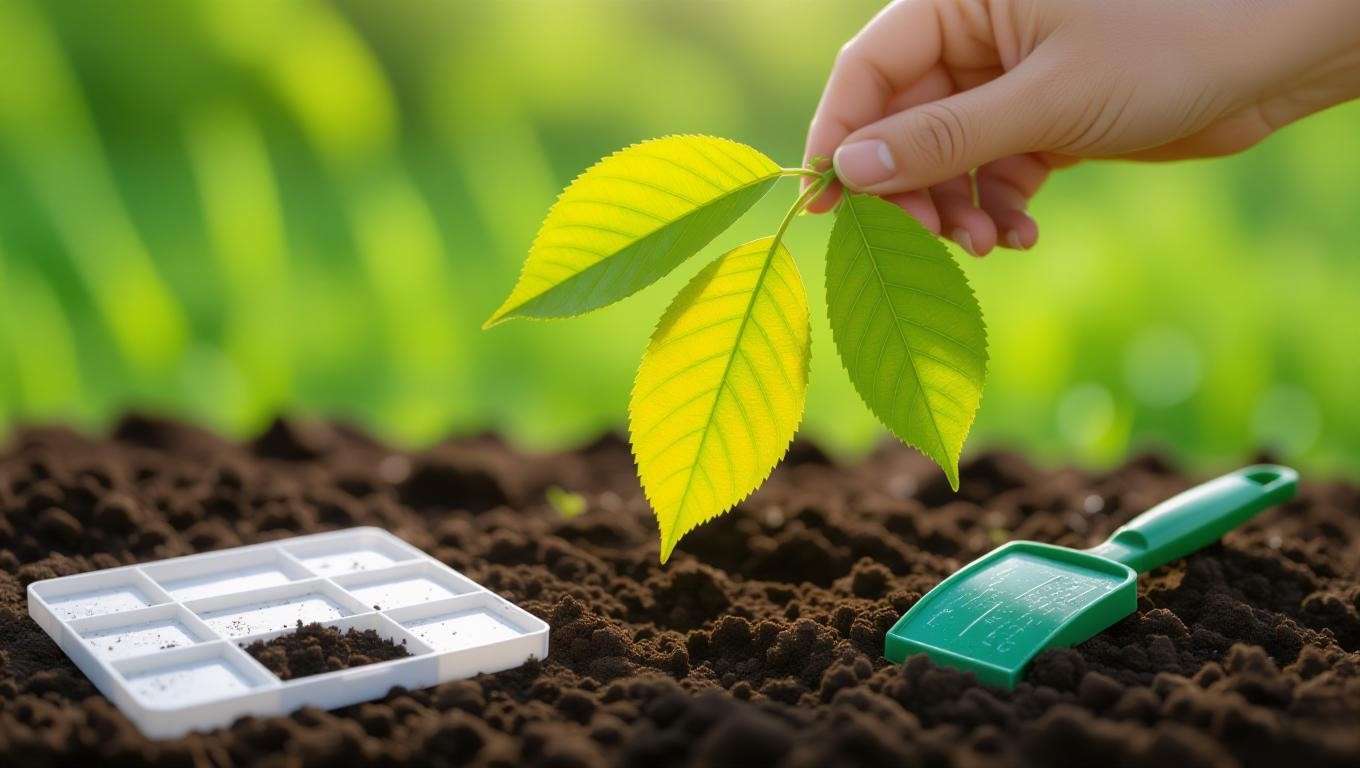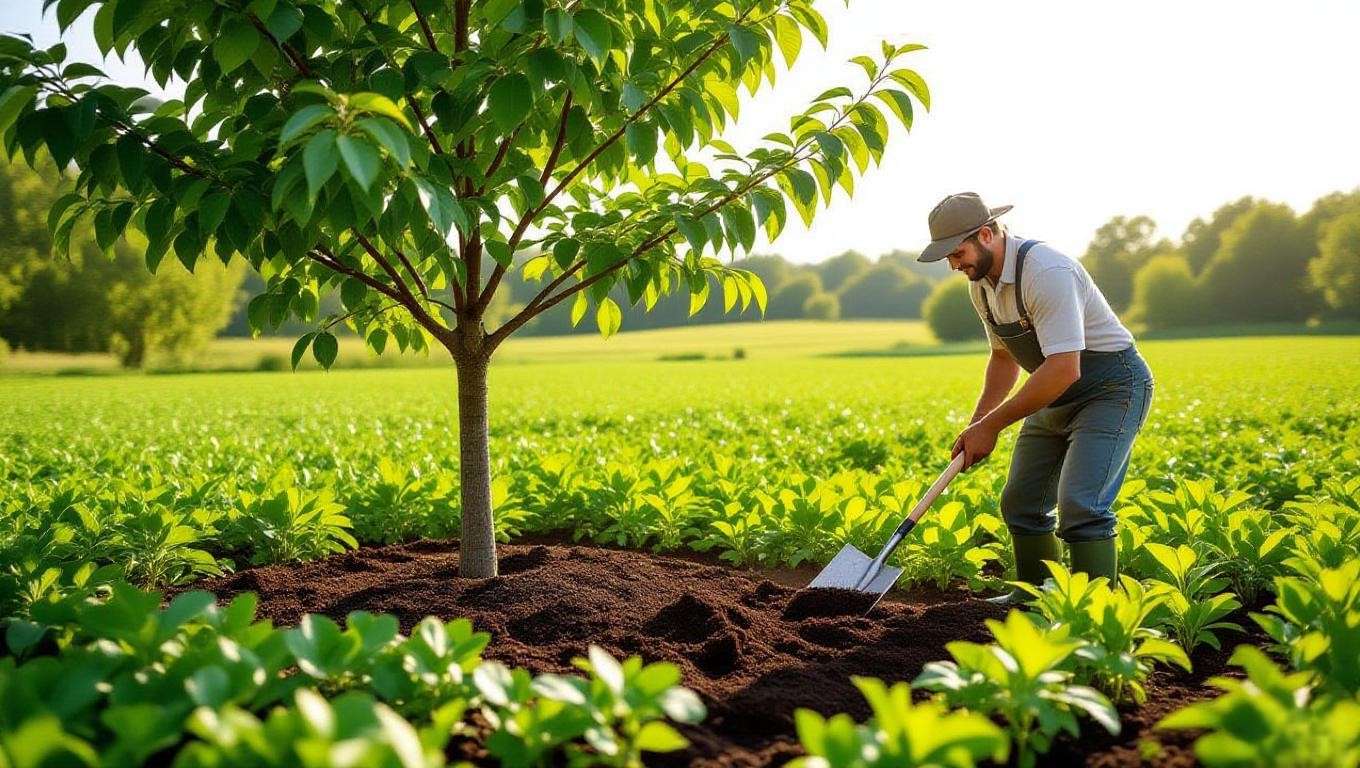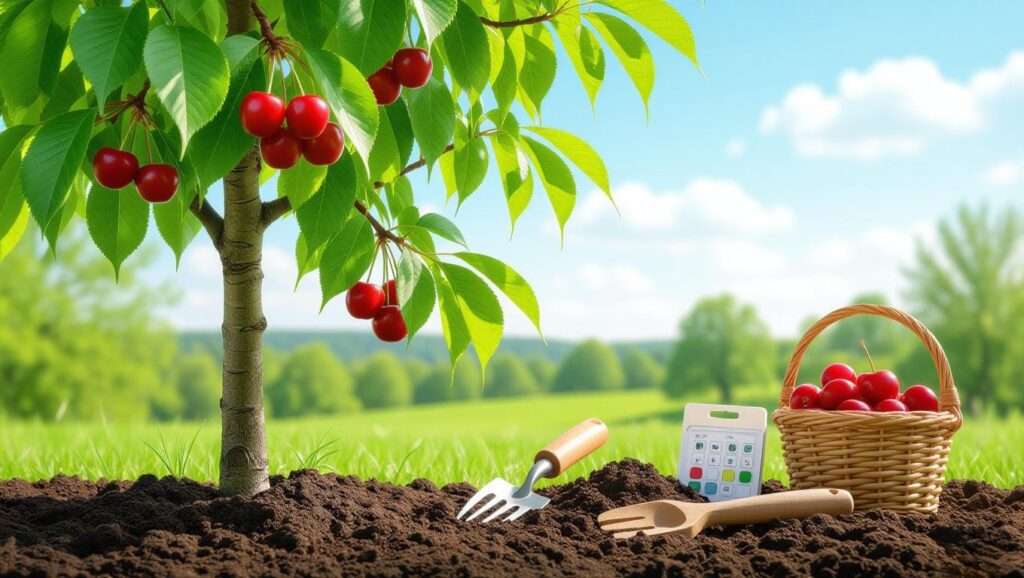Picture this: your cherry tree, once a vibrant centerpiece of your garden, now droops with yellowing leaves and lackluster fruit. The culprit? Nutrient deficiencies. Learning how to fix cherry tree nutrient deficiencies is key to restoring your tree’s health and ensuring bountiful harvests. As a plant care enthusiast, you know a thriving cherry tree is more than just a pretty sight—it’s a source of delicious fruit and pride. In this comprehensive guide, backed by horticultural expertise and real-world insights, we’ll walk you through identifying, correcting, and preventing nutrient deficiencies to keep your cherry trees flourishing. Ready to transform your tree? Let’s dive in! 🍒
Understanding Cherry Tree Nutrient Deficiencies 🧑🌾
What Are Nutrient Deficiencies in Cherry Trees? 🤔
Nutrient deficiencies occur when cherry trees lack essential elements needed for growth, flowering, and fruit production. These elements—macronutrients like nitrogen, phosphorus, and potassium, and micronutrients like iron and magnesium—are vital for processes like photosynthesis and root development. Unlike pests or diseases, nutrient deficiencies stem from imbalances in soil or improper care, leading to weakened trees and poor yields. According to the University of California’s agricultural extension, cherry trees are particularly sensitive to nutrient imbalances due to their high metabolic demands during fruiting seasons.
Common Signs of Nutrient Deficiencies 🍂
Spotting nutrient deficiencies early can save your cherry tree from long-term damage. Here are the most common symptoms:
- Nitrogen Deficiency: Pale green or yellow leaves, stunted growth, and small, sparse fruit.
- Phosphorus Deficiency: Dark green or purplish leaves, reduced flowering, and weak root systems.
- Potassium Deficiency: Scorched leaf edges, weak branches, and small, low-quality fruit.
- Micronutrient Deficiencies: Chlorosis (yellowing between leaf veins), leaf spotting, or abnormal growth patterns.
For example, a home gardener in Oregon noticed her cherry tree’s leaves turning yellow and dropping prematurely. A soil test revealed low nitrogen levels, which she corrected with a targeted fertilizer. Below is a quick-reference table for visual cues:
| Nutrient | Symptoms | Visual Cues |
|---|---|---|
| Nitrogen | Pale leaves, slow growth | Yellowing older leaves |
| Phosphorus | Poor flowering, weak roots | Purplish leaf discoloration |
| Potassium | Scorched leaves, small fruit | Brown, curled leaf edges |
| Iron | Chlorosis | Yellow leaves with green veins |
Why Cherry Trees Are Prone to Deficiencies 🌱
Cherry trees are nutrient-hungry, especially during their flowering and fruiting phases. Several factors increase their vulnerability:
- Soil Type: Sandy or clay-heavy soils often lack sufficient nutrients or retain them poorly.
- Soil pH: Cherry trees thrive in slightly acidic soil (pH 6.0–6.5). Alkaline or overly acidic soils can lock up nutrients, making them unavailable.
- Climate: Heavy rainfall can leach nutrients, while drought stresses roots, limiting uptake.
- Poor Management: Over-fertilizing or neglecting soil health can disrupt nutrient balance.
A 2023 study from Washington State University found that improper fertilization practices were a leading cause of nutrient deficiencies in cherry orchards, emphasizing the need for tailored care.
Diagnosing Nutrient Deficiencies with Precision 🔍
Conducting a Soil Test 🌍
A soil test is the gold standard for diagnosing nutrient deficiencies. Here’s how to do it:
- Collect Samples: Use a clean trowel to gather soil from 6–12 inches deep around the tree’s drip line (the area under the canopy’s edge).
- Mix and Send: Combine samples from multiple spots, let them air-dry, and send to a reputable lab (e.g., your local agricultural extension service).
- Interpret Results: Look for pH, macronutrient levels (N, P, K), and micronutrients (e.g., iron, zinc). Most labs provide recommendations for amendments.
For reliable results, consider services like those offered by Cornell University’s Nutrient Analysis Laboratory. A typical soil test costs $15–$50 and provides a detailed nutrient profile.

Leaf Analysis for Accurate Diagnosis 🍃
Leaf tissue analysis complements soil testing by revealing what nutrients the tree is actually absorbing. Follow these steps:
- Timing: Collect leaves in mid-summer, when nutrient levels stabilize.
- Sampling: Pick 50–100 healthy leaves from different parts of the tree, avoiding damaged ones.
- Lab Submission: Send samples to a certified lab, following their packaging guidelines.
Expert Tip: Work with a lab accredited by the North American Proficiency Testing Program for accurate results. Leaf analysis can pinpoint deficiencies that soil tests might miss, especially for micronutrients.
Visual Inspection Tips from Experts 👀
While lab tests are ideal, visual inspections can provide quick clues. Use this checklist:
- Leaf Color: Yellowing or purplish hues often indicate nitrogen or phosphorus issues.
- Growth Patterns: Stunted shoots or sparse flowering suggest nutrient shortages.
- Fruit Quality: Small, tasteless fruit may point to potassium or micronutrient deficiencies.
Be cautious: symptoms like yellow leaves can also indicate overwatering or pests. Cross-reference visual signs with soil or leaf tests to avoid misdiagnosis. Diagrams of deficiency symptoms (e.g., chlorosis patterns) can help, so consider consulting resources like the USDA’s Plant Nutrient Deficiency Guide.
Fixing Cherry Tree Nutrient Deficiencies: Step-by-Step Solutions 🛠️
Addressing Nitrogen Deficiency 🌿
Symptoms: Pale green or yellow leaves (starting with older ones), slow growth, and reduced fruit size.
Solutions:
- Apply a nitrogen-rich fertilizer, such as ammonium sulfate (21-0-0) or composted manure.
- Dosage: Use 0.1–0.2 pounds of actual nitrogen per year of tree age (up to 2 pounds total). For example, a 5-year-old tree needs 0.5–1 pound.
- Timing: Apply in early spring, just before bud break, to support new growth.
- Spread fertilizer evenly around the drip line and water thoroughly.
Expert Insight: Avoid over-fertilizing, as excess nitrogen can cause leaf burn or excessive vegetative growth at the expense of fruit. A cherry grower in Michigan reported a 30% increase in fruit yield after correcting nitrogen deficiency with a balanced fertilizer plan.

Correcting Phosphorus Deficiency 🌸
Symptoms: Dark green or purplish leaves, reduced flowering, and weak root systems.
Solutions:
- Use phosphorus-based fertilizers like bone meal (3-15-0) or rock phosphate (0-20-0).
- Application: Incorporate 1–2 pounds per tree into the soil or use foliar sprays for faster uptake.
- Timing: Apply in early spring or fall to support root and flower development.
Case Study: A small cherry orchard in Washington struggled with sparse blooms. After a soil test revealed low phosphorus, the grower applied bone meal and saw a 25% increase in flowering the next season. Always test soil first to avoid over-application, which can harm soil microbiology.
Tackling Potassium Deficiency 🍒
Symptoms: Scorched or curled leaf edges, weak branches, and small, low-quality fruit.
Solutions:
- Apply potassium sulfate (0-0-50) or wood ash (sparingly, due to high alkalinity).
- Dosage: Use 0.5–1 pound per tree, spread around the drip line.
- Timing: Apply in late winter or early spring to prepare for fruiting.
Potassium supports fruit quality and disease resistance. Overuse, however, can disrupt calcium uptake, so balance is key. Monitor soil levels annually to maintain optimal potassium.
Managing Micronutrient Deficiencies (Iron, Magnesium, Zinc) ⚙️
Symptoms:
- Iron: Yellow leaves with green veins (chlorosis), especially in young leaves.
- Magnesium: Yellowing between veins in older leaves.
- Zinc: Small, distorted leaves and reduced fruit set.
Solutions:
- Use chelated micronutrient sprays (e.g., chelated iron or zinc) for quick absorption.
- Apply soil amendments like compost tea or seaweed extract for long-term benefits.
- Dosage: Follow product labels (e.g., 1–2 ounces per gallon of water for foliar sprays).
- Organic Options: Composted manure or fish emulsion can boost micronutrient levels naturally.
| Micronutrient | Symptoms | Fix |
|---|---|---|
| Iron | Chlorosis in young leaves | Chelated iron spray |
| Magnesium | Yellowing older leaves | Epsom salt (magnesium sulfate) |
| Zinc | Small, distorted leaves | Zinc sulfate foliar spray |
Expert Tip: Foliar sprays work faster than soil amendments for micronutrients, especially in alkaline soils where uptake is limited.
Adjusting Soil pH for Optimal Nutrient Uptake ⚖️
Cherry trees thrive in soil with a pH of 6.0–6.5. Outside this range, nutrients become less available, even if present in the soil. Here’s how to adjust:
- Acidic Soil (pH < 6.0): Apply agricultural lime (calcium carbonate) at 2–5 pounds per 100 square feet, based on soil test recommendations.
- Alkaline Soil (pH > 6.5): Use elemental sulfur or aluminum sulfate at 1–2 pounds per 100 square feet.
- Timing: Apply amendments in fall or early spring, allowing time for soil adjustment.
Preventing Future Nutrient Deficiencies 🛡️
Building Healthy Soil for Long-Term Success 🌾
Healthy soil is the foundation of a thriving cherry tree. Nutrient-rich, well-structured soil ensures your tree can access the elements it needs year-round. Here’s how to build and maintain fertile soil:
- Add Organic Matter: Incorporate compost, well-rotted manure, or leaf mold into the soil annually. Aim for 2–3 inches of organic matter spread around the tree’s drip line. This boosts nutrient levels and improves soil structure.
- Use Cover Crops: Plant nitrogen-fixing cover crops like clover or vetch in the off-season. These crops enhance soil fertility and prevent erosion. A study from Oregon State University found that cover crops increased soil nitrogen by up to 20% in orchards.
- Mulch Regularly: Apply a 2–4 inch layer of organic mulch (e.g., wood chips, straw) around the base of the tree, keeping it 6 inches from the trunk to prevent rot. Mulch retains moisture, regulates soil temperature, and slowly releases nutrients.

Seasonal Soil Maintenance Checklist:
- Spring: Add compost and test soil pH.
- Summer: Monitor moisture and add mulch as needed.
- Fall: Incorporate cover crops or organic amendments.
- Winter: Avoid soil disturbance to protect root systems.
Proper Fertilization Practices 📅
A balanced fertilization schedule prevents nutrient deficiencies before they start. Here’s how to fertilize cherry trees effectively:
- Choose the Right Fertilizer: Use a balanced fertilizer (e.g., 10-10-10) for young trees or a nitrogen-focused one (e.g., 16-20-0) for mature, fruiting trees. Organic options like fish emulsion or blood meal are excellent for sustainable care.
- Timing: Apply fertilizers in early spring, just before bud break, to support growth. A second, lighter application in early summer can boost fruit development.
- Application Method: Spread granular fertilizers evenly around the drip line and water deeply. For liquid fertilizers, dilute according to package instructions and apply via watering can or sprayer.
- Dosage: Follow soil test recommendations, but a general rule is 0.1–0.2 pounds of nitrogen per year of tree age, up to 2 pounds total.
Expert Insight: Work with your local agricultural extension service to create a customized fertilization plan based on soil tests and tree age. Over-fertilization can lead to nutrient imbalances or environmental runoff, so precision is key.
Watering and Mulching Tips 💧
Proper irrigation and mulching are critical for nutrient uptake and retention. Follow these best practices:
- Watering: Cherry trees need 1–2 inches of water per week during the growing season. Use a soaker hose or drip irrigation to deliver water directly to the root zone, avoiding leaf wetness that can invite disease.
- Mulching: Maintain a 2–4 inch mulch layer to reduce evaporation and prevent nutrient leaching. Organic mulches like bark or straw also decompose, adding nutrients to the soil.
- Do’s and Don’ts:
- Do: Water deeply but infrequently to encourage deep roots.
- Don’t: Overwater, as soggy soil can leach nutrients and cause root rot.
- Do: Refresh mulch annually to maintain coverage.
- Don’t: Pile mulch against the tree trunk, as this can lead to fungal issues.
A cherry grower in California reported a 15% increase in fruit size after implementing drip irrigation and mulching, highlighting the impact of consistent moisture on nutrient absorption.

Expert Tips and Best Practices for Cherry Tree Care 🌟
To elevate your cherry tree care, consider these advanced tips from horticulturists and arborists:
- Companion Planting: Plant nutrient-enhancing companions like comfrey or alfalfa near cherry trees. These plants accumulate minerals in their leaves, which decompose into the soil, boosting fertility.
- Integrated Pest Management (IPM): Healthy trees resist pests better. Combine nutrient management with IPM practices like monitoring for aphids or using beneficial insects to reduce stress on your tree.
- Pruning for Nutrient Efficiency: Prune in late winter to remove dead or crowded branches, directing nutrients to healthy growth. A well-pruned tree uses nutrients more effectively for fruit production.
- Sustainable Practices: Opt for organic fertilizers and avoid synthetic chemicals that can disrupt soil microbiology. Compost tea, made from well-rotted compost, is a nutrient-rich, eco-friendly option.
Myth vs. Fact:
- Myth: More fertilizer always means healthier trees.
- Fact: Over-fertilizing can cause nutrient burn or imbalances, harming your tree.
- Myth: All yellow leaves indicate a nitrogen deficiency.
- Fact: Yellowing can also signal overwatering, pests, or micronutrient issues—always test to confirm.
FAQs: Your Cherry Tree Nutrient Questions Answered ❓
Q1: How can I tell if my cherry tree has a nutrient deficiency or a disease?
A: Nutrient deficiencies typically show uniform symptoms (e.g., yellowing leaves across the tree), while diseases often cause localized damage (e.g., spots, wilting branches). Conduct a soil or leaf test to confirm deficiencies, and consult a local extension service for disease diagnosis.
Q2: Can I use household items to fix nutrient deficiencies?
A: Yes, but sparingly. Epsom salt (magnesium sulfate) can address magnesium deficiencies, and crushed eggshells can add calcium. However, soil tests are crucial to avoid over-application, as household remedies aren’t always balanced.
Q3: How often should I fertilize my cherry tree?
A: Fertilize once in early spring and, if needed, lightly in early summer. Over-fertilizing can harm trees, so follow soil test recommendations.
Q4: What’s the best time of year to address nutrient deficiencies?
A: Early spring is ideal for most corrections, as trees are gearing up for growth. Fall applications can prepare soil for the next season.
Q5: Are organic fertilizers effective for cherry trees?
A: Yes! Organic options like compost, manure, or fish emulsion provide slow-release nutrients and improve soil health. They’re especially effective when paired with regular soil testing.
Conclusion: Grow Thriving Cherry Trees with Confidence 🌳
Nutrient deficiencies can dim the vibrancy of your cherry trees, but with the right knowledge, you can restore their health and enjoy bountiful harvests. By diagnosing deficiencies with soil and leaf tests, applying targeted fertilizers, and maintaining healthy soil, you’ll set your trees up for long-term success. Start today: test your soil, adjust your care routine, and watch your cherry trees thrive. Have a success story or question? Share it in the comments below or explore our other guides on cherry tree pruning and variety selection for more tips! 🍒













